Conducting effective graphic design interviews can be challenging, especially when you're trying to gauge both technical skills and creative flair. This list will help you pinpoint the right questions that can differentiate between merely good applicants and those who truly stand out by also considering aspects like visual reasoning.
In this blog post, we provide a comprehensive collection of graphic design interview questions tailored to different skill levels, from beginners to intermediate designers. Each section includes specific questions and answers covering various aspects such as color theory and typography.
By utilizing these questions, you can enhance your interview process and identify top-tier graphic design talent. Consider augmenting your interviews with an aptitude test for graphic designers to streamline the hiring process further.
Table of contents
15 basic Graphic Design interview questions and answers to assess applicants
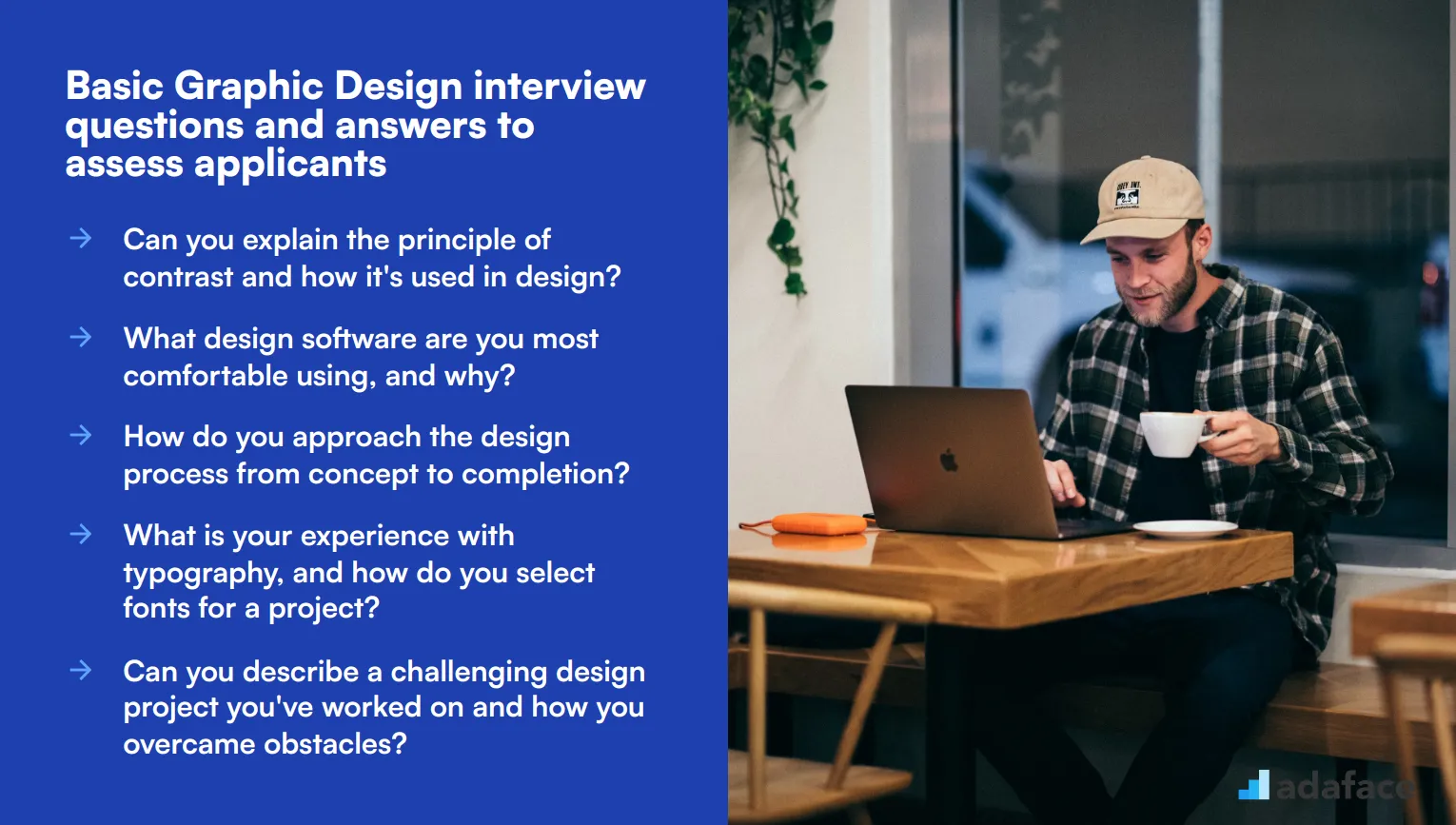
To effectively evaluate your graphic design applicants, it's essential to ask the right questions. This list of basic graphic design interview questions will help you gauge their skills and understanding of fundamental concepts. Use these questions to identify candidates who can contribute to your projects and align with your team's goals. For a detailed understanding of what to look for, check out this graphic designer job description.
- Can you explain the principle of contrast and how it's used in design?
- What design software are you most comfortable using, and why?
- How do you approach the design process from concept to completion?
- What is your experience with typography, and how do you select fonts for a project?
- Can you describe a challenging design project you've worked on and how you overcame obstacles?
- How do you ensure your designs are user-friendly and accessible?
- What role does color theory play in your design work?
- How do you handle constructive criticism of your designs?
- Can you explain the difference between raster and vector graphics?
- What is your approach to working within brand guidelines while still being creative?
- How do you stay updated with the latest design trends and technologies?
- Can you show us your portfolio and explain the story behind one of your favorite pieces?
- How do you prioritize tasks when working on multiple design projects simultaneously?
- What methods do you use to gather feedback from stakeholders during the design process?
- How do you measure the success of your designs after implementation?
9 Graphic Design interview questions and answers to evaluate junior designers
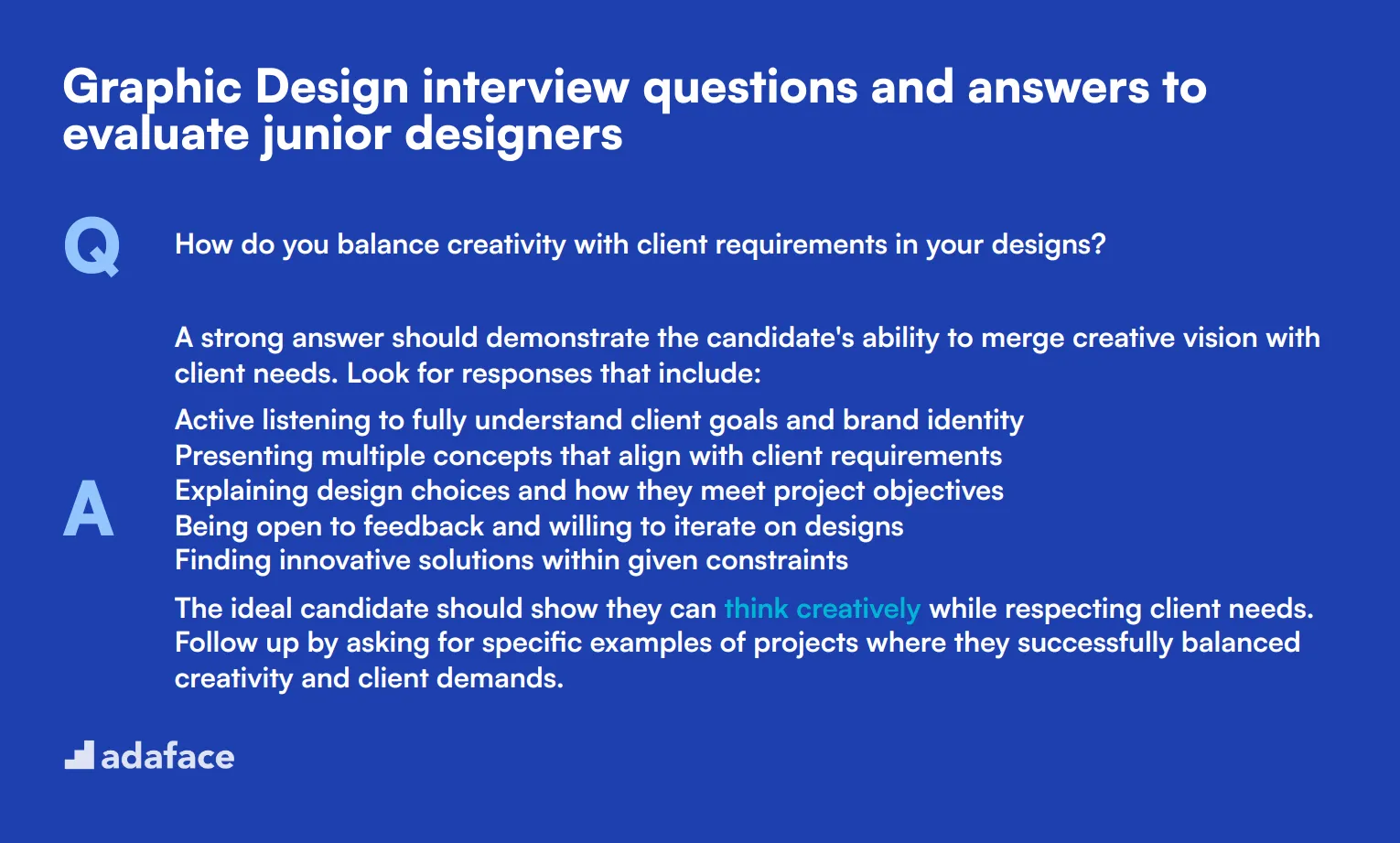
Ready to spot the next design superstar? These nine graphic design interview questions are your secret weapon for evaluating junior designers. They'll help you uncover raw talent, assess creative thinking, and gauge technical know-how. Use them to find that perfect blend of artistic flair and practical skills your team needs.
1. How do you balance creativity with client requirements in your designs?
A strong answer should demonstrate the candidate's ability to merge creative vision with client needs. Look for responses that include:
- Active listening to fully understand client goals and brand identity
- Presenting multiple concepts that align with client requirements
- Explaining design choices and how they meet project objectives
- Being open to feedback and willing to iterate on designs
- Finding innovative solutions within given constraints
The ideal candidate should show they can think creatively while respecting client needs. Follow up by asking for specific examples of projects where they successfully balanced creativity and client demands.
2. Can you walk me through your process for creating a logo from start to finish?
A comprehensive answer should include the following steps:
- Research: Understanding the client, industry, and competitors
- Brainstorming: Sketching initial ideas and concepts
- Refinement: Selecting the best concepts for digital development
- Design: Creating vector versions and exploring color options
- Presentation: Showcasing the logo in various applications
- Revision: Incorporating client feedback
- Finalization: Preparing final files in various formats
Look for candidates who emphasize the importance of research and client communication throughout the process. A strong answer will also mention creating a versatile logo that works across different mediums and sizes.
3. How do you ensure your designs are accessible to people with disabilities?
A good answer should demonstrate awareness of accessibility principles and include strategies such as:
- Using sufficient color contrast for text and background
- Providing alternative text for images
- Ensuring designs are keyboard-navigable
- Using clear, readable fonts and appropriate font sizes
- Avoiding reliance on color alone to convey information
- Considering screen reader compatibility in digital designs
The ideal candidate should show a commitment to inclusive design and familiarity with accessibility guidelines like WCAG. Consider asking follow-up questions about specific tools or resources they use to check accessibility.
4. How do you approach designing for different screen sizes and devices?
A strong answer should demonstrate understanding of responsive design principles and may include:
- Starting with a mobile-first approach
- Using flexible grid systems and breakpoints
- Considering touch targets and user interactions on different devices
- Optimizing images and assets for various screen resolutions
- Testing designs across multiple devices and screen sizes
- Collaborating with developers to ensure proper implementation
Look for candidates who emphasize the importance of user experience across all devices. A good follow-up question might be to ask about specific challenges they've faced when designing for multiple screen sizes and how they overcame them.
5. How do you stay inspired and generate fresh ideas for your designs?
A good answer might include various sources of inspiration and techniques such as:
- Regularly browsing design websites, blogs, and social media
- Creating mood boards or inspiration collections
- Attending design conferences or workshops
- Experimenting with new tools and techniques
- Drawing inspiration from nature, architecture, or other art forms
- Collaborating and brainstorming with team members
- Taking breaks and engaging in non-design activities to refresh creativity
The ideal candidate should demonstrate a proactive approach to seeking inspiration and a genuine passion for design. Look for answers that show a balance between staying current with design trends and developing a unique creative voice.
6. How do you handle tight deadlines without compromising the quality of your work?
A strong answer should demonstrate time management skills and problem-solving abilities. Key points might include:
- Prioritizing tasks and creating a realistic timeline
- Communicating clearly with team members and clients about expectations
- Using templates or pre-built elements when appropriate
- Focusing on essential design elements first
- Knowing when to ask for help or delegate tasks
- Utilizing time-saving tools and shortcuts in design software
Look for candidates who can balance efficiency with quality. A good follow-up question might be to ask for a specific example of a project where they successfully managed a tight deadline.
7. How do you approach designing for a brand you're not personally drawn to?
A thoughtful answer should demonstrate professionalism and adaptability. Key points might include:
- Focusing on understanding the target audience rather than personal preferences
- Conducting thorough research on the brand and its competitors
- Separating personal taste from professional judgment
- Seeking input from team members or focus groups
- Finding aspects of the project that are challenging or interesting
- Viewing it as an opportunity to expand skills and versatility
The ideal candidate should show they can set aside personal biases to create effective designs for any client. Consider asking for an example of a project where they successfully designed for a brand or product they weren't initially excited about.
8. How do you incorporate feedback from non-designers into your work?
A good answer should demonstrate strong communication skills and a collaborative mindset. Key points might include:
- Actively listening to understand the core of the feedback
- Asking clarifying questions to get specific, actionable input
- Educating non-designers on design principles when necessary
- Finding compromises that satisfy stakeholders without compromising design integrity
- Using visual examples or mockups to illustrate design decisions
- Remaining open-minded and seeing feedback as an opportunity for improvement
Look for candidates who can balance respect for others' input with confidence in their own expertise. A good follow-up question might be to ask about a time when they successfully incorporated challenging feedback into a design.
9. How do you ensure consistency across different design pieces for a single brand or campaign?
A comprehensive answer should demonstrate understanding of brand consistency and attention to detail. Key points might include:
- Creating and adhering to a detailed style guide
- Developing templates for common design elements
- Using consistent color palettes, typography, and imagery across all pieces
- Regularly reviewing all design elements together to ensure cohesion
- Utilizing design software features like shared libraries or assets
- Collaborating closely with team members to maintain consistency
The ideal candidate should emphasize the importance of systematic approaches to maintaining brand consistency. Consider asking about specific tools or processes they've used to ensure consistency across large projects or campaigns.
18 intermediate Graphic Design interview questions and answers to ask mid-tier designers
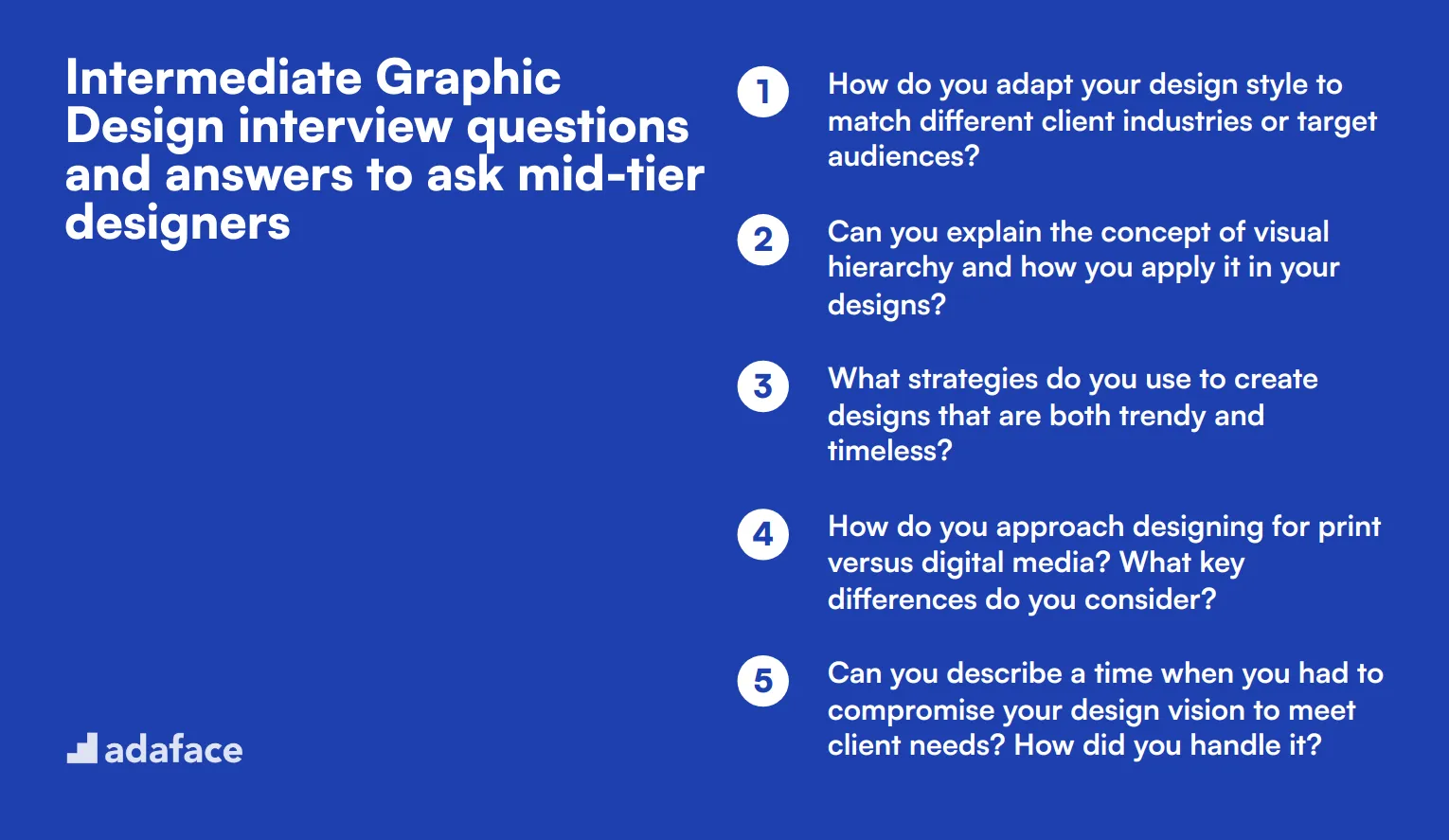
When interviewing mid-tier graphic designers, it's crucial to assess their advanced skills and problem-solving abilities. These 18 intermediate graphic design interview questions will help you evaluate candidates' expertise and creative thinking. Use them to gain deeper insights into their design process and technical proficiency.
- How do you adapt your design style to match different client industries or target audiences?
- Can you explain the concept of visual hierarchy and how you apply it in your designs?
- What strategies do you use to create designs that are both trendy and timeless?
- How do you approach designing for print versus digital media? What key differences do you consider?
- Can you describe a time when you had to compromise your design vision to meet client needs? How did you handle it?
- What techniques do you use to create visual interest in minimalist designs?
- How do you ensure your designs are culturally sensitive and inclusive?
- Can you explain the importance of white space in design and how you utilize it effectively?
- What's your approach to creating a cohesive visual identity across various marketing materials?
- How do you incorporate storytelling elements into your graphic designs?
- Can you describe your process for creating infographics that are both informative and visually appealing?
- How do you balance form and function in your designs, especially for user interfaces?
- What techniques do you use to make your designs stand out in a crowded digital space?
- How do you approach redesigning an existing brand identity while maintaining its core values?
- Can you explain how you use grid systems in your design work?
- What's your strategy for designing effective call-to-action elements?
- How do you ensure your designs are optimized for different social media platforms?
- Can you describe a time when you had to work with limited resources or constraints? How did you overcome this challenge?
8 Graphic Design interview questions and answers related to color theory
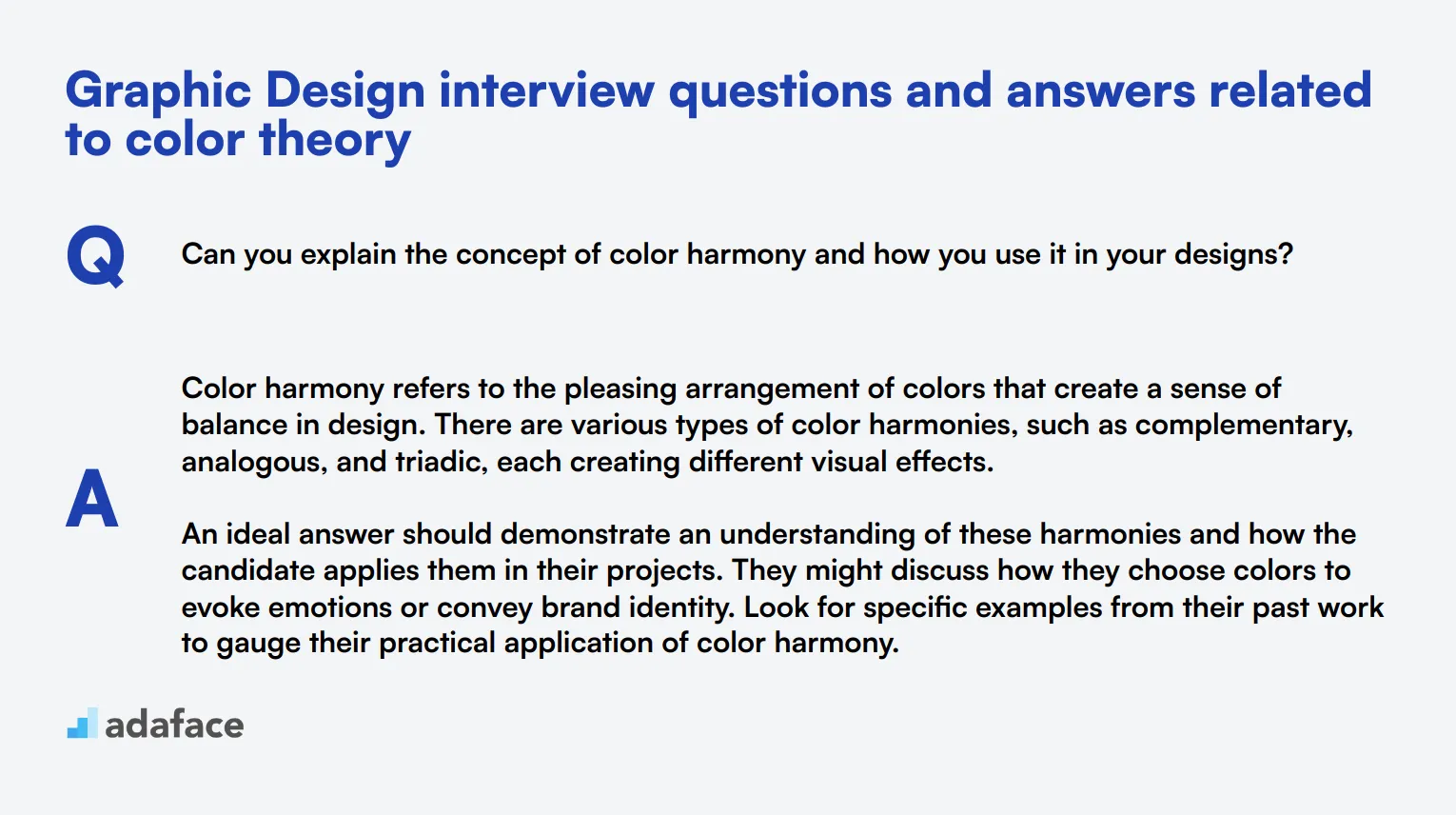
If you're looking to gauge a candidate's understanding of color theory in graphic design, these interview questions can help you pinpoint their knowledge and application skills. Use this list when you want to dig deeper into how they use color to create impactful designs.
1. Can you explain the concept of color harmony and how you use it in your designs?
Color harmony refers to the pleasing arrangement of colors that create a sense of balance in design. There are various types of color harmonies, such as complementary, analogous, and triadic, each creating different visual effects.
An ideal answer should demonstrate an understanding of these harmonies and how the candidate applies them in their projects. They might discuss how they choose colors to evoke emotions or convey brand identity. Look for specific examples from their past work to gauge their practical application of color harmony.
2. How do you decide which color palette to use for a project?
Choosing a color palette involves considering the project's objectives, target audience, and the emotions you want to evoke. A designer might start with a primary color based on the brand or project theme and then select complementary or contrasting colors to complete the palette.
Candidates should mention tools or techniques they use for this process, such as color wheels, digital tools, or mood boards. Look for a structured approach and the ability to justify their choices with design principles and project requirements.
3. Describe a time when you had to adjust your color choices based on client feedback. How did you handle it?
Adjusting color choices based on client feedback is a common scenario. A strong candidate will describe how they listened to the client's concerns, understood the underlying reasons for the feedback, and made adjustments while maintaining the design's integrity.
Look for a balanced approach where the candidate shows flexibility and problem-solving skills. An ideal response would include a specific example and explain how they effectively communicated the changes and ensured client satisfaction.
4. How do you ensure that your color choices are accessible to all users?
Ensuring color accessibility involves using contrast ratios that meet web accessibility standards and considering color blindness. Designers often use tools to check color contrast and create designs that are readable and usable for all users.
Candidates should mention specific tools or techniques they use, such as color contrast checkers and designing with patterns or textures to differentiate elements. Look for an understanding of accessibility guidelines and a commitment to inclusive design practices.
5. What role does color temperature play in your design process?
Color temperature refers to the warmth or coolness of a color, which can influence the mood and perception of a design. Warm colors like red and yellow can evoke energy and excitement, while cool colors like blue and green create a calming effect.
An ideal answer should demonstrate how the candidate uses color temperature to enhance the message and emotional impact of their designs. Look for examples where they strategically used color temperature to align with the project's goals.
6. How do you incorporate brand colors into your designs without overwhelming the viewer?
Incorporating brand colors effectively involves balance and hierarchy. Designers use brand colors as primary or accent colors while pairing them with neutral or complementary colors to avoid overwhelming the viewer.
Candidates should discuss techniques like using brand colors for key elements and balancing them with white space or neutral backgrounds. Look for a thoughtful approach that respects brand guidelines while ensuring visual appeal.
7. Can you explain the psychological effects of colors and how you use them in your designs?
Colors can evoke specific emotions and reactions. For example, blue often conveys trust and calm, while red can evoke excitement or urgency. Understanding these psychological effects helps designers create effective and impactful designs.
Look for candidates who can provide specific examples of how they used color psychology in their projects. An ideal answer should show their ability to align color choices with the intended message and audience response.
8. How do you stay updated on the latest trends and theories in color usage for design?
Staying updated on color trends involves continuous learning through design blogs, industry publications, and attending workshops or conferences. Designers might also experiment with new color palettes and tools to keep their skills sharp.
An ideal response should indicate a proactive approach to learning and curiosity about evolving design trends. Look for candidates who can cite specific resources or recent trends they have incorporated into their work.
12 Graphic Design interview questions about typography
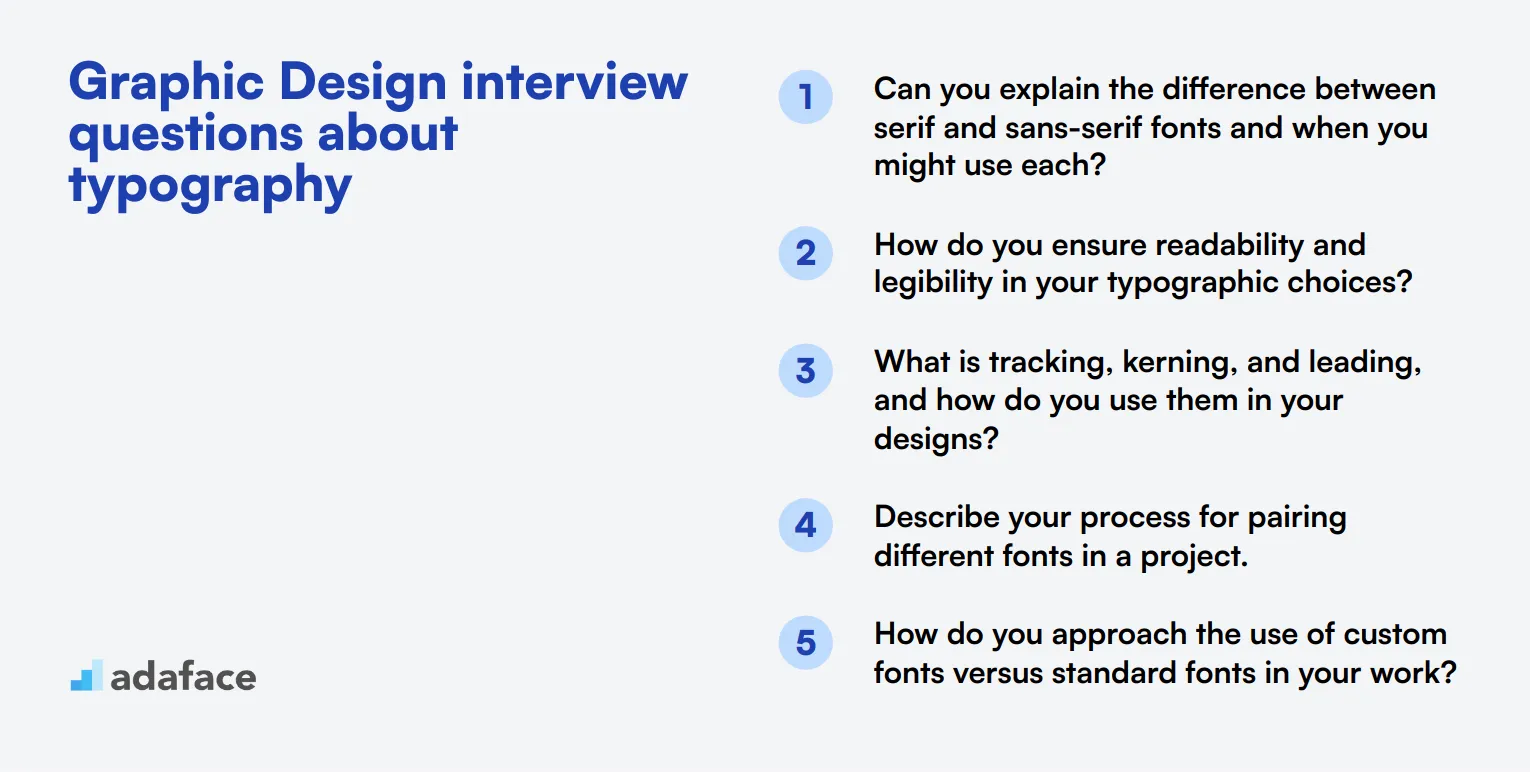
To effectively evaluate a candidate's mastery of typography in graphic design, consider using these targeted interview questions. These questions will help you assess their technical skills, creativity, and understanding of crucial typographic principles, ensuring you find the right fit for your team. For more information on essential skills for a graphic designer, refer to this resource.
- Can you explain the difference between serif and sans-serif fonts and when you might use each?
- How do you ensure readability and legibility in your typographic choices?
- What is tracking, kerning, and leading, and how do you use them in your designs?
- Describe your process for pairing different fonts in a project.
- How do you approach the use of custom fonts versus standard fonts in your work?
- Can you provide an example of how you used typography to enhance the message of a design?
- How do you handle situations where text content changes frequently in a design project?
- What role does typographic hierarchy play in your designs, and how do you establish it?
- How do you balance creative typography with brand guidelines?
- Can you discuss a time when you had to make a difficult typographic decision? What was the outcome?
- How do you incorporate accessibility considerations into your typographic designs?
- What are some common typographic mistakes to avoid in graphic design?
10 situational Graphic Design interview questions for hiring top designers
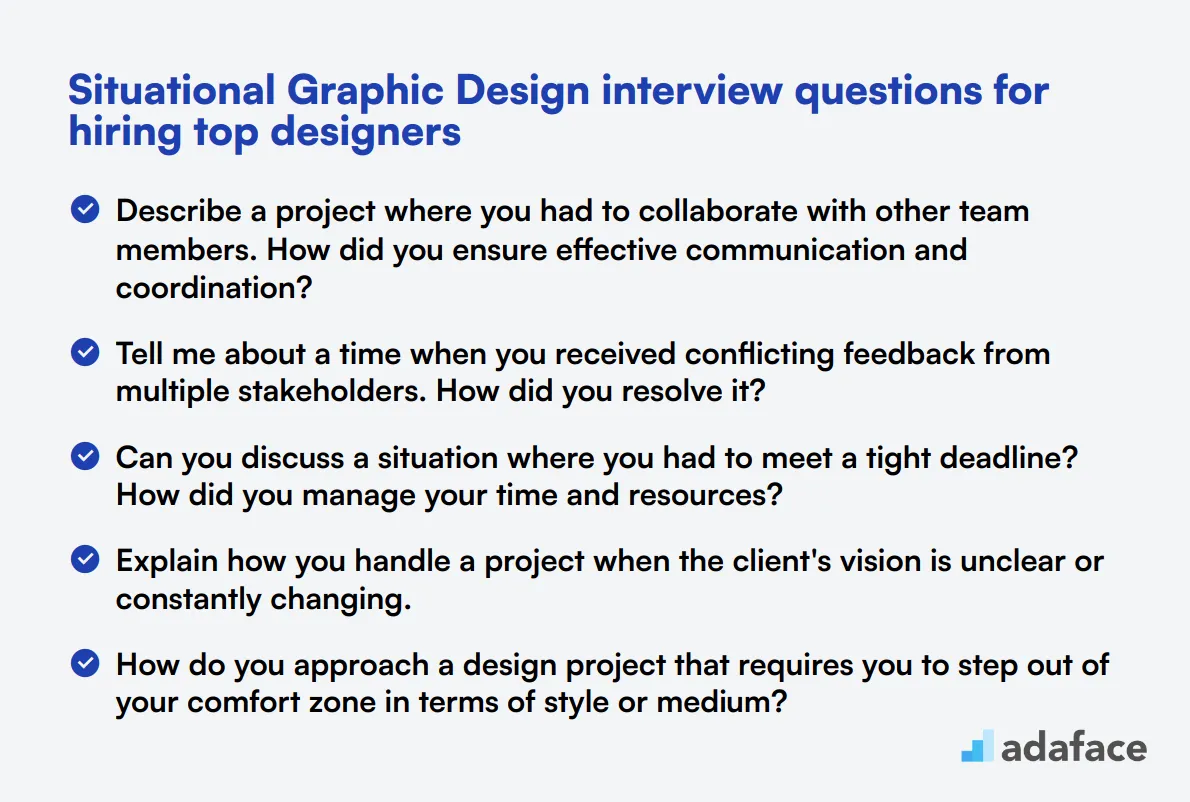
To hire top graphic designers who can handle various real-world scenarios, use these situational interview questions. These questions will help you evaluate how candidates think on their feet and apply their skills in different contexts, ensuring you select the best fit for your team. For more detailed job descriptions, refer to our graphic designer job description.
- Describe a project where you had to collaborate with other team members. How did you ensure effective communication and coordination?
- Tell me about a time when you received conflicting feedback from multiple stakeholders. How did you resolve it?
- Can you discuss a situation where you had to meet a tight deadline? How did you manage your time and resources?
- Explain how you handle a project when the client's vision is unclear or constantly changing.
- How do you approach a design project that requires you to step out of your comfort zone in terms of style or medium?
- Describe a scenario where you had to design for a completely new industry. What steps did you take to understand the industry and its audience?
- Can you give an example of a time when you had to integrate new technology or tools into your design process? How did you adapt?
- Tell me about a design project where you had to balance creativity with strict compliance or legal guidelines.
- How do you approach feedback when it contradicts your design principles? Can you provide an example?
- Describe a situation where you had to rework a design multiple times. How did you maintain your motivation and ensure quality?
Which Graphic Design skills should you evaluate during the interview phase?
While it's impossible to evaluate every aspect of a candidate's graphic design abilities in a single interview, focusing on core skills is crucial. These key competencies form the foundation of a designer's toolkit and provide insight into their potential contributions.

Visual Design
Visual design is at the heart of graphic design. It encompasses the ability to create aesthetically pleasing and effective visual solutions that communicate messages clearly.
To assess visual design skills, consider using an assessment test with relevant multiple-choice questions. These can help filter candidates based on their understanding of design principles and aesthetics.
During the interview, ask targeted questions to evaluate the candidate's visual design capabilities. Here's an example:
Can you walk me through your process for creating a visually appealing and effective logo design?
Look for responses that demonstrate a structured approach, consideration of client needs, research, sketching, and refinement. Candidates should mention elements like color theory, typography, and scalability.
Software Proficiency
Proficiency in industry-standard design software is essential for graphic designers. It enables them to efficiently execute their ideas and collaborate with team members.
To gauge a candidate's software skills, consider asking:
Which design software are you most comfortable with, and can you describe a complex project where you utilized multiple tools?
Pay attention to the candidate's familiarity with popular design software like Adobe Creative Suite. Look for examples that showcase their ability to leverage different tools for various aspects of a project.
Typography
Typography is a fundamental element of graphic design. A strong grasp of typography principles allows designers to enhance readability, convey tone, and create visual hierarchy.
To assess typography skills, you might ask:
How do you approach selecting and pairing fonts for a branding project?
Listen for responses that demonstrate knowledge of font categories, legibility considerations, and the ability to create visual harmony. Candidates should mention factors like brand personality, target audience, and application across different mediums.
Hire Top Graphic Design Talent with Adaface Skills Tests and Interview Questions
If you are looking to hire someone with graphic design skills, it's important to accurately assess their abilities. Ensuring candidates meet your skill requirements is the first step in finding the right fit for your team.
One effective way to do this is by using skill tests. Consider using Adaface’s Graphic Designer Assessment or UI/UX Design Test to evaluate candidates' capabilities.
After administering these tests, you can shortlist the best applicants and invite them for interviews. This approach helps you focus on top talent and makes your hiring process more streamlined.
To get started, visit our test library or sign up today. Leverage Adaface to find the perfect graphic design expert for your team.
Graphic Designer Aptitude Test
Download Graphic Design interview questions template in multiple formats
Graphic Design Interview Questions FAQs
This post covers basic, junior, intermediate, color theory, typography, and situational Graphic Design interview questions for various skill levels.
The post includes a total of 72 Graphic Design interview questions across different categories and skill levels.
Yes, these Graphic Design interview questions can be used for both in-person and remote interviews to assess candidates' skills and knowledge.
Use a mix of questions from different categories to assess various aspects of a candidate's Graphic Design skills, experience, and problem-solving abilities.

40 min skill tests.
No trick questions.
Accurate shortlisting.
We make it easy for you to find the best candidates in your pipeline with a 40 min skills test.
Try for freeRelated posts
Free resources




